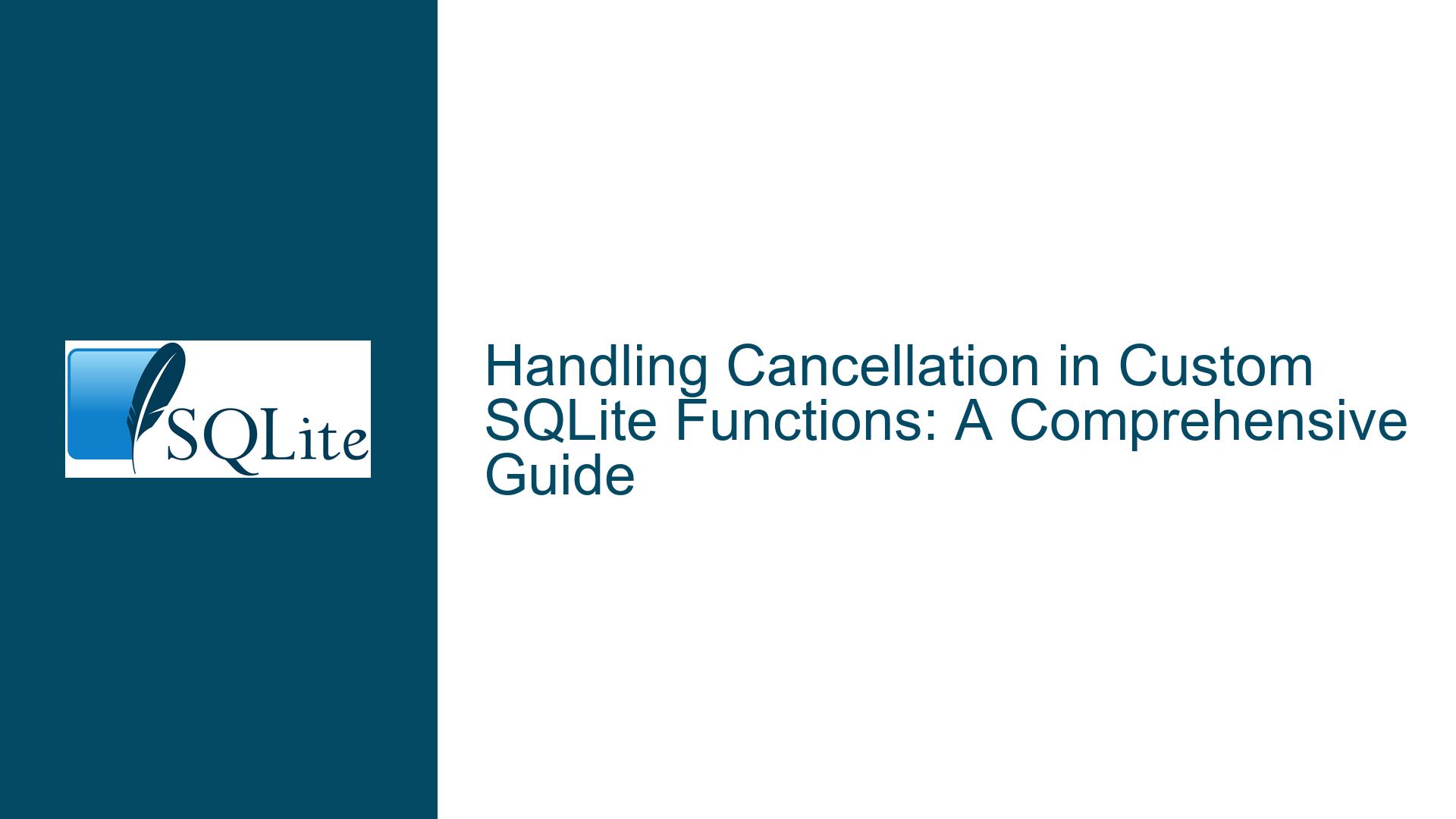Handling Cancellation in Custom SQLite Functions: A Comprehensive Guide
Understanding the Challenge of Cancelling Long-Running Custom SQLite Functions
Custom SQLite functions are a powerful feature that allows developers to extend SQLite’s capabilities by implementing user-defined functions in languages like C# or C. However, when these functions perform computationally intensive tasks or rely on external resources, they can take a significant amount of time to execute. This raises the question of how to gracefully cancel such long-running functions when necessary, especially in scenarios where user intervention or system constraints demand immediate termination.
The core issue revolves around the lack of a built-in mechanism in SQLite to notify custom functions of a cancellation request. SQLite provides the sqlite3_interrupt() function, which can be used to cancel a running query. However, this function operates at a high level, interrupting the Virtual Database Engine (VDBE) instructions that execute SQL statements. Custom functions, on the other hand, are treated as single VDBE instructions, meaning that SQLite has no direct way to interrupt their execution once they have started.
This limitation becomes particularly problematic when custom functions are performing tasks that cannot be easily divided into smaller, interruptible chunks. For example, a custom function that performs complex mathematical calculations or interacts with external APIs may not have natural breakpoints where it can check for cancellation requests. As a result, developers are left with no straightforward way to implement cancellation logic in their custom functions.
Exploring the Underlying Causes of the Cancellation Limitation
The inability to cancel custom SQLite functions stems from the architecture of SQLite’s execution model. SQLite processes SQL statements by compiling them into a series of VDBE instructions, which are then executed sequentially. Each instruction represents a discrete operation, such as fetching a row from a table or performing a calculation. Custom functions are implemented as a single VDBE instruction, which means that SQLite treats them as atomic operations.
When sqlite3_interrupt() is called, SQLite sets an internal flag that is checked between VDBE instructions. If the flag is set, SQLite stops executing further instructions and returns control to the caller. However, since custom functions are treated as single instructions, there is no opportunity for SQLite to check the interrupt flag during their execution. This design ensures that custom functions have complete control over their execution but also makes it difficult to implement cancellation logic.
Another factor contributing to the cancellation limitation is the lack of a standardized API for custom functions to check for interruption requests. While SQLite provides a rich set of APIs for interacting with the database, there is no built-in mechanism for custom functions to query the interrupt status of the current connection. This means that even if a custom function wanted to implement cancellation logic, it would have no way to determine whether a cancellation request had been made.
Implementing Cancellation in Custom SQLite Functions: Solutions and Best Practices
To address the challenge of cancelling long-running custom SQLite functions, developers can leverage the newly introduced sqlite3_is_interrupted() function. This function, which was added to SQLite’s core library in response to community feedback, provides a way for custom functions to check whether an interruption request has been made. By periodically calling sqlite3_is_interrupted() within their custom functions, developers can implement cancellation logic that allows the function to exit gracefully when a cancellation request is detected.
The sqlite3_is_interrupted() function works by accepting a sqlite3_context* parameter, which represents the context of the current SQL function call. The function then checks the interrupt flag associated with the underlying database connection and returns a boolean value indicating whether an interruption request has been made. This allows custom functions to determine whether they should continue executing or exit early.
To use sqlite3_is_interrupted() effectively, developers should structure their custom functions to include periodic checks for interruption requests. For example, if a custom function is performing a series of calculations, it can call sqlite3_is_interrupted() after each calculation to determine whether it should continue. If the function detects an interruption request, it can clean up any resources it has allocated and return an appropriate error code or result.
In addition to using sqlite3_is_interrupted(), developers should also consider the following best practices when implementing cancellation logic in custom SQLite functions:
Minimize the Impact of Cancellation: When a custom function is cancelled, it should clean up any resources it has allocated and return a consistent result. This ensures that the database remains in a valid state and that subsequent queries can be executed without issues.
Use Timeouts for External Operations: If a custom function relies on external resources, such as network requests or file I/O, it should use timeouts to limit the amount of time spent waiting for these operations to complete. This reduces the risk of the function becoming unresponsive and makes it easier to implement cancellation logic.
Document Cancellation Behavior: Developers should clearly document the cancellation behavior of their custom functions, including how they respond to interruption requests and what cleanup operations they perform. This helps other developers understand how to use the functions correctly and ensures that cancellation logic is implemented consistently across the codebase.
Test Cancellation Scenarios: Developers should thoroughly test their custom functions to ensure that they handle cancellation requests correctly. This includes testing scenarios where the function is cancelled at different points during its execution and verifying that the function cleans up resources and returns consistent results in all cases.
By following these best practices and leveraging the sqlite3_is_interrupted() function, developers can implement robust cancellation logic in their custom SQLite functions. This allows them to create more responsive and reliable applications that can gracefully handle user interruptions and system constraints.
Conclusion
Cancelling long-running custom SQLite functions is a challenging problem that requires careful consideration of SQLite’s execution model and the limitations of its API. By understanding the underlying causes of the cancellation limitation and leveraging the newly introduced sqlite3_is_interrupted() function, developers can implement effective cancellation logic in their custom functions. This not only improves the responsiveness and reliability of their applications but also ensures that the database remains in a valid state even when functions are interrupted. With the right approach and best practices, developers can overcome the challenges of cancelling custom SQLite functions and create more robust and user-friendly applications.






